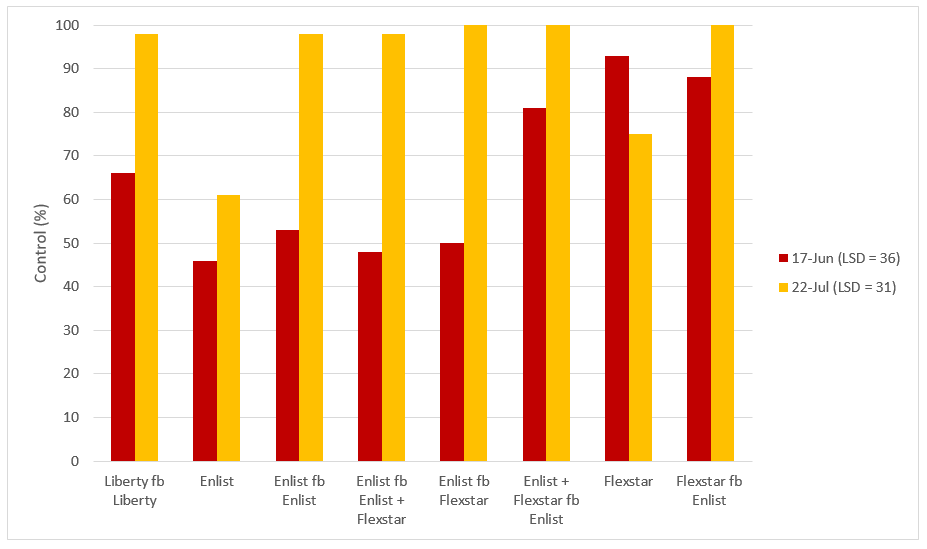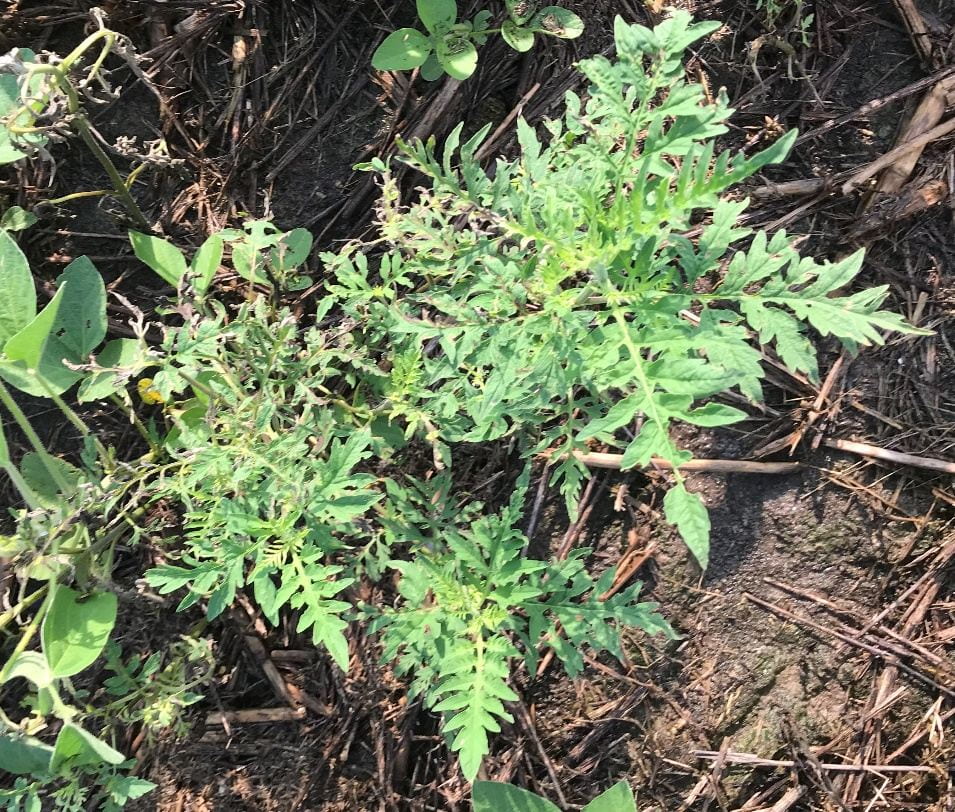Kurt Vollmer, Weed Management Specialist
University of Maryland Extension
Introduction
In Maryland, populations of common ragweed have developed resistance to three sites-of-action. These include Group 9 herbicides (glyphosate), Group 2 herbicides (ALS-inhibiting; Synchrony, Raptor), and Group 14 herbicides (PPO-inhibiting; Flexstar, Valor). These herbicide-resistant populations limit options for effective postemergence control. Previously glyphosate could be used to control common ragweed at various growth stages. However, herbicides that continue to provide postemergence control, such as glufosinate (Liberty) and 2,4-D (Enlist One) are less effective when common ragweed exceeds heights in excessive of 3 inches tall (Figure 1). If preemergence herbicides are ineffective and/or postemergence applications are delayed, common ragweed can quickly exceed this optimal control height. As a result, multiple post-emergence applications may be required to manage this weed.

Objectives
The objective of this study was to evaluate herbicide programs for the management of common ragweed 4 inches tall or greater.
Methods
The study was conducted in a grower field in Snow Hill, MD with a history of herbicide-resistant common ragweed. Enlist E3 soybeans (tolerant to 2,4-D, glyphosate, and glufosinate) were drilled in 15 inch rows on May 19, 2020 at a rate of 52 lb/A. In order to ensure a better stand of common ragweed, additional weed competition was eliminated with a broadcast treatment of glyphosate + Dual II Magnum applied on May 21. Dual II Magnum provides residual control of certain annual grasses and small seeded broadleaf weeds, but does not control common ragweed. Postemergence herbicides were applied on June 9, to 4 to 12 inch tall common ragweed, and a second postemergence application was made 17 days later on June 26. Treatments included Liberty, Enlist One, and Flexstar applied alone or in tank mixes as single or sequential herbicide applications (Table 1).
Table 1. Postemergence herbicide treatments for control of large common ragweed.
| Treatment No. | Application Aa | Rate (pt/A) | Application Bb | Rate (pt/A) | |
| 1 | Liberty | 2.7 | Liberty | 2.7 | |
| 2 | Enlist One | 2 | —- | —- | |
| 3 | Enlist One | 2 | Enlist One | 2 | |
| 4 | Enlist One | 2 | Enlist One + Flexstar | 2 + 1.6 | |
| 5 | Enlist One | 2 | Flexstar | 1.6 | |
| 6 | Enlist One + Flexstar | 2 + 1.6 | Enlist One | 2 | |
| 7 | Flexstar | 1.6 | —- | —- | |
| 8 | Flexstar | 1.6 | Enlist One | 2 |
a.Treatments applied June 9, 2020.
b.Treatments applied June 26, 2020.
Results
Sequential applications were needed to provide at least 95% control of common ragweed (Figure 2). On June 17, prior to the second postemergence application, control of common ragweed with Liberty was less than 70%, and control with Enlist One averaged 56%. On July 22, sequential treatments of Liberty, Enlist, and Flexstar controlled common ragweed better than Enlist One applied once.

a. Ratings for June 17 are the result of application A. Ratings for June 22 are the result of application A + application B. Treatments not followed by (fb) a second treatment were applied once, on June 17.
Summary
These results emphasize the importance of timely postemergence herbicide applications in controlling common ragweed. Delaying applications increases the likelihood that common ragweed will not be controlled with a single application, and sequential applications will be needed to manage this species effectively. However, additional research is needed to confirm these results and help identify consistent treatments.
In addition, herbicide-tolerant soybeans were needed in order to apply Enlist One and Liberty. Historically, Group 2 herbicides, such as Raptor, and Group 14 herbicides, such as Reflex, have been used to control common ragweed in non-herbicide tolerant soybeans. In this study, Flexstar alone provided good control early on, but common ragweed control declined within a month after application (Figures 2 and 3). Furthermore, in Maryland, Flexstar applications can only be made once every other year, and would not be suitable if sequential applications are required. In order to manage these populations, conventional soybean growers will likely have to adopt or continue to use soybeans tolerant to 2,4-D and/or glufosinate. Several soybean varieties are available that contain tolerance multiple herbicide groups. These not only offer more flexibility for postemergence herbicide programs, but also offer the option of tank-mixing different herbicide groups for improved control. Further research is needed on how this approach can improve control of common ragweed and mitigate further herbicide resistance development.

Acknowledgements
This research was funded by the Maryland Soybean Board.
